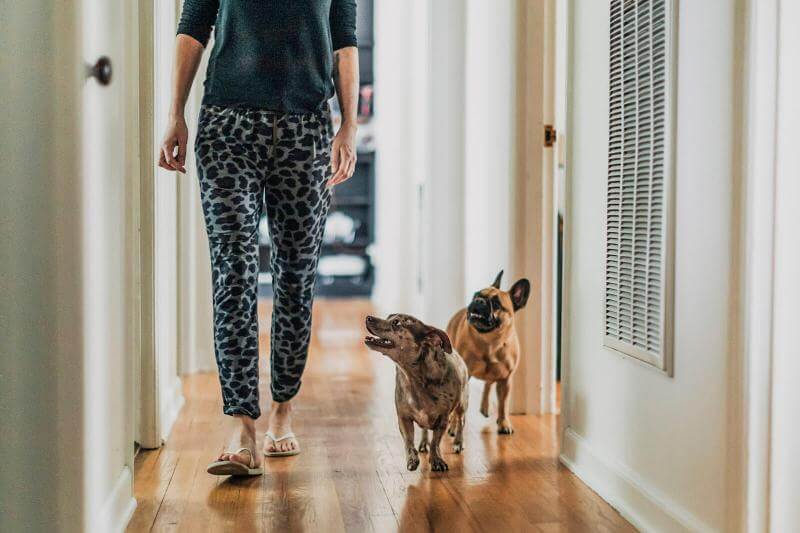In the delightful tapestry of human-canine relationships, a common thread binds us— the unwavering companionship of our furry friends. Have you ever wondered, “Why does my dog follow me everywhere?” This exploration embarks on a journey into the heart of canine behavior, delving into the reasons behind this endearing habit. From the instinctual loyalty ingrained in their DNA to the emotional connections that define our bond, we unravel the mysteries of why our four-legged companions choose to be our constant shadows. Join us in deciphering the language of devotion, uncovering the subtle cues that make “My Dog Follows Me Everywhere” a testament to the unique and cherished connection between us and our beloved pets.
Understanding dog Instincts
Unveiling the Intriguing World of Canine Curiosity
Dogs, our faithful companions, are inherently curious creatures, and this curiosity extends far beyond what meets the eye. In this exploration, we delve into the fascinating realm of canine instincts, focusing specifically on their insatiable curiosity that knows no borders.
1. Canine Sensory Prowess
Dogs experience the world primarily through their senses. Their acute sense of smell, hearing, and sight allows them to perceive the environment in ways humans can only imagine. This heightened sensory awareness fuels their innate curiosity to explore every nook and cranny, transcending physical boundaries.
2. Instinctual Exploration
From the evolutionary perspective, dogs are natural hunters and scavengers. In the wild, survival depends on their ability to investigate their surroundings for food, potential threats, and suitable shelter. This instinctual exploration has persisted through domestication, manifesting as an inquisitive nature that compels them to follow scents and investigate their surroundings.
3. The Bathroom as a Microcosm
The bathroom, a seemingly mundane space to us, becomes a microcosm of intrigue to our canine companions. Its enclosed nature intensifies their curiosity, prompting them to follow us into this private domain. Understanding this behavior requires recognizing the bathroom as a confined space that amplifies their natural instinct to investigate and ensure the safety of their pack (you).
4. Strengthening the Human-Canine Bond
Acknowledging and appreciating this instinctual curiosity is pivotal in strengthening the bond between humans and dogs. Engaging with your dog during their exploratory ventures fosters a sense of companionship and satisfies their need for mental stimulation.
Practical Implications for Pet Owners
Understanding your dog’s curiosity has practical implications for pet owners:
1. Enrichment Activities
Incorporate enrichment activities into your dog’s routine to stimulate their mind and satisfy their curiosity. Puzzle toys, scent games, and interactive play sessions provide outlets for their instinctual exploration.
2. Training Opportunities
Utilize their curiosity as a training opportunity. Channel their inquisitive nature into positive behaviors through basic obedience training, rewarding them for responding to commands.
3. Safe Exploration Spaces
Create safe spaces within your home or yard where your dog can explore freely. This allows them to satisfy their curiosity without exposing them to potential dangers.
4. Mental Stimulation
Recognize the importance of mental stimulation in your dog’s overall well-being. Engage in activities that challenge their intellect, providing a healthy outlet for their natural instincts.
The Pack Mentality
You Are Their Pack
In the wild, dogs thrive in packs, relying on each other for protection and companionship. When your dog follows you, it’s an expression of their pack mentality. This section explores the psychology behind your dog seeing you as the leader of their pack.
Emotional Connection
A Four-Legged Shadow
Beyond instincts, there’s a profound emotional connection that prompts your dog to be your constant companion. Dogs are known for their loyalty, and this section uncovers the emotional reasons behind their need to follow you everywhere.
Separation Anxiety
Understanding the Fear of Abandonment
1. Canine Emotional Bonds
Dogs form strong emotional bonds with their owners, viewing them as a source of security and comfort. The fear of abandonment arises when they perceive a potential separation, triggering anxiety.
2. Previous Traumatic Experiences
Dogs with a history of abandonment or mistreatment may carry emotional scars, making them more susceptible to separation anxiety. Past traumatic experiences contribute significantly to the fear of being left alone.
3. Lack of Independence Conditioning
Dogs that haven’t been gradually conditioned to independence may struggle when left alone. The abrupt departure of their owner can evoke a sense of abandonment, intensifying their anxiety.
4. Signs of Fear and Distress
Manifestations of separation anxiety include destructive behavior, excessive barking, house soiling, and attempts to escape. These actions are desperate attempts to cope with the perceived abandonment, driven by fear.
Addressing the Fear: Effective Strategies
1. Gradual Independence Training
Implementing a systematic approach to independence training helps desensitize dogs to being alone. Start with short intervals, gradually increasing the time spent away to build their confidence.
2. Creating Positive Associations
Associate departures with positive experiences by offering treats, toys, or engaging activities before leaving. This helps shift the focus from fear to positive anticipation.
3. Establishing Predictable Routines
Dogs thrive on routines. Establishing consistent daily schedules provides a sense of security, minimizing the anxiety triggered by uncertainty.
4. Utilizing Comfort Items
Introduce comfort items such as blankets or toys that carry the owner’s scent. These items act as reassuring companions in the owner’s absence.
Professional Guidance and Intervention
1. Veterinary Consultation
If separation anxiety persists, seeking guidance from a veterinarian is crucial. They can rule out any underlying health issues contributing to the behavior.
2. Professional Dog Training
Enlisting the help of a professional dog trainer experienced in behavioral issues provides targeted strategies for managing and alleviating separation anxiety.
Training and Conditioning
Can It Be Modified?
Explore the training aspect of your dog’s behavior. Can this habit be modified, and what training techniques can be employed to encourage independent behavior? This section provides practical insights for dog owners looking to address this behavior.
Tips for Healthy Independence
Striking the Right Balance
While a close bond with your dog is cherished, fostering healthy independence is equally important. This section offers tips on striking the right balance, ensuring your dog feels secure while embracing moments of solo exploration.
Understanding Body Language
Decoding Canine Signals
Your dog communicates through body language. This section provides a guide to understanding your dog’s signals, helping you interpret when they need companionship and when they crave alone time.
When to Seek Professional Advice
Addressing Behavioral Concerns
For dog owners facing persistent behavioral issues related to constant following, seeking professional advice becomes crucial. This section offers guidance on when and how to consult with a veterinarian or professional dog trainer.
Conclusion
In the tapestry of human-canine companionship, the question of “Why does my dog follow me everywhere?” weaves a story of instinct, loyalty, and emotional connection. Understanding these elements deepens the bond between you and your furry friend, creating a relationship built on trust and companionship.
FAQs About My Dog Following Me Everywhere
- Is it normal for my dog to follow me everywhere?
- Yes, dogs often exhibit this behavior due to their natural instincts and strong emotional connection with their owners.
- How can I encourage my dog to be more independent?
- Gradual training and providing a comfortable space for your dog to retreat to can encourage healthy independence.
- What should I do if my dog shows signs of separation anxiety?
- Consult with a veterinarian or professional dog trainer to address separation anxiety through training and behavioral techniques.
- Can certain breeds be more prone to following behavior?
- While individual temperament varies, certain breeds are known for their loyalty and may exhibit following behavior more prominently.
- When should I be concerned about my dog’s constant following?
- If the behavior becomes obsessive, interferes with their well-being, or is accompanied by signs of distress, seeking professional advice is recommended.






